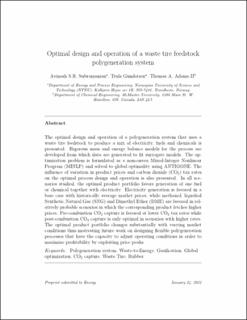| dc.contributor.author | Rammohan Subramanian, Avinash Shankar | |
| dc.contributor.author | Gundersen, Truls | |
| dc.contributor.author | Adams II, Thomas A | |
| dc.date.accessioned | 2021-11-04T12:53:31Z | |
| dc.date.available | 2021-11-04T12:53:31Z | |
| dc.date.created | 2021-02-15T20:52:12Z | |
| dc.date.issued | 2021 | |
| dc.identifier.citation | Energy. 2021, 223 . | en_US |
| dc.identifier.issn | 0360-5442 | |
| dc.identifier.uri | https://hdl.handle.net/11250/2827913 | |
| dc.description.abstract | The optimal design and operation of a polygeneration system that uses a waste tire feedstock to produce a mix of electricity, fuels and chemicals is presented. Rigorous mass and energy balance models for the process are developed from which data are generated to fit surrogate models. The optimization problem is formulated as a nonconvex Mixed-Integer Nonlinear Program (MINLP) and solved to global optimality using ANTIGONE. The influence of variation in product prices and carbon dioxide (CO2) tax rates on the optimal process design and operation is also presented. In all scenarios studied, the optimal product portfolio favors generation of one fuel or chemical together with electricity. Electricity generation is favored in a base case with historically average market prices, while methanol, liquefied Synthetic Natural Gas (SNG) and Dimethyl Ether (DME) are favored in relatively probable scenarios in which the corresponding product fetches higher prices. Pre-combustion CO2 capture is favored at lower CO2 tax rates while post-combustion CO2 capture is only optimal in scenarios with higher rates. The optimal product portfolio changes substantially with varying market conditions thus motivating future work on designing flexible polygeneration processes that have the capacity to adjust operating conditions in order to maximize profitability by exploiting price peaks. | en_US |
| dc.language.iso | eng | en_US |
| dc.publisher | Elsevier | en_US |
| dc.rights | Attribution-NonCommercial-NoDerivatives 4.0 Internasjonal | * |
| dc.rights.uri | http://creativecommons.org/licenses/by-nc-nd/4.0/deed.no | * |
| dc.title | Optimal design and operation of a waste tire feedstock polygeneration system | en_US |
| dc.type | Peer reviewed | en_US |
| dc.type | Journal article | en_US |
| dc.description.version | acceptedVersion | en_US |
| dc.rights.holder | This is the authors' accepted manuscript to an article published by Elsevier. Locked until 5.2.2023 due to copyright restrictions. The AAM is made available under the CC-BY-NC-ND 4.0 license http://creativecommons.org/licenses/by-nc-nd/4.0/ | en_US |
| dc.source.pagenumber | 13 | en_US |
| dc.source.volume | 223 | en_US |
| dc.source.journal | Energy | en_US |
| dc.identifier.doi | 10.1016/j.energy.2021.119990 | |
| dc.identifier.cristin | 1890136 | |
| cristin.ispublished | true | |
| cristin.fulltext | postprint | |
| cristin.qualitycode | 2 | |

